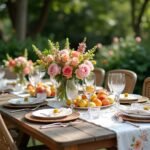Spring is just around the corner and with it the time to transform our balconies and gardens back into blooming oases. Flower boxes offer the perfect opportunity to create a colorful paradise even in the smallest of spaces and at the same time combine different plants according to individual preferences.
Whether sunny or shady, herbs, perennials or annual summer flowers – the design options for flower boxes are almost limitless. With the right planning and combination of plants, you can enjoy varied planting all year round, which is not only pleasing to the eye but also provides a valuable habitat for insects.
Planting flower boxes correctly – basics and preparation
The plants are planted according to the tried and tested principle of “thrill, fill and spill”: taller, eye-catching plants are placed in the middle (thrill), medium-sized plants around them (fill) and overhanging plants at the edge (spill). When planting, make sure that the plants are at the same height as in the pot and press the soil down carefully. After watering, a layer of mulch should be applied to retain the moisture.
The best plants for window boxes in spring
For lush blooms, the plants should be planted in nutrient-rich potting soil and watered regularly. Withered flowers should be removed so that new buds can form. With the right care and a sunny to partially shaded location, the heralds of spring will continue to bloom until May and bring a lot of joy to balconies and patios with their blaze of color.
Designing summer flower boxes
The right care is crucial for a long flowering period: regular watering, especially on hot days, and removing wilted flowers keep the plants vital. Good drainage and high-quality potting soil form the basis for healthy growth, while regular fertilization also supports flower formation.
Autumn planting for balcony boxes
Heuchera, autumn heather and hardy pansies are particularly easy to care for and robust. In combination with autumnal accessories such as small pumpkins or twigs, they lend the balcony a cozy atmosphere. The right substrate mixture and regular watering ensure that the plants remain vital well into the winter.
Hardy plants for window boxes
Wintergreen ground cover plants such as ivy, forest stonecrop or periwinkle are particularly easy to care for and can be spread over the boxes and combined with other plants. Add early-flowering bulbs such as snowdrops, crocuses or winter aconites to create a varied arrangement that brings color and structure to the balcony planting from winter to spring.
Flower boxes for sunny locations
Proper care is crucial for vital plants in sunny locations. Regular watering in the early morning or late evening prevents evaporation losses. A mulch layer of bark material stores additional moisture. Regularly removing faded plant parts and fertilizing every two weeks will keep the plants vital and blooming throughout the summer.
Shade-loving plants in the flower box
Funkias, woodruff and lady’s mantle are particularly robust and easy to care for. They form lush foliage and create a natural look. Flowering shade plants such as begonias or fuchsias, which create beautiful accents with their bright colors, are suitable additions. Regular fertilization during the growth phase supports healthy development.
Edible plants for balcony boxes
For successful cultivation, the balcony boxes should be placed in a sunny to semi-shady location. The soil must be nutrient-rich and well-drained, and regular watering and occasional fertilization are important for a rich harvest. It is particularly practical to combine different plants in one box, whereby attention should be paid to different growth heights and nutrient requirements.
Design flower boxes as privacy screens
Designing a privacy screen with flower boxes requires well thought-out planning. In addition to selecting suitable containers of sufficient size and stability, correct positioning also plays an important role. The boxes should be securely fastened and offer enough space for the roots to develop. With a combination of evergreen and flowering plants, the privacy screen remains attractive all year round and also fulfills its practical purpose.














